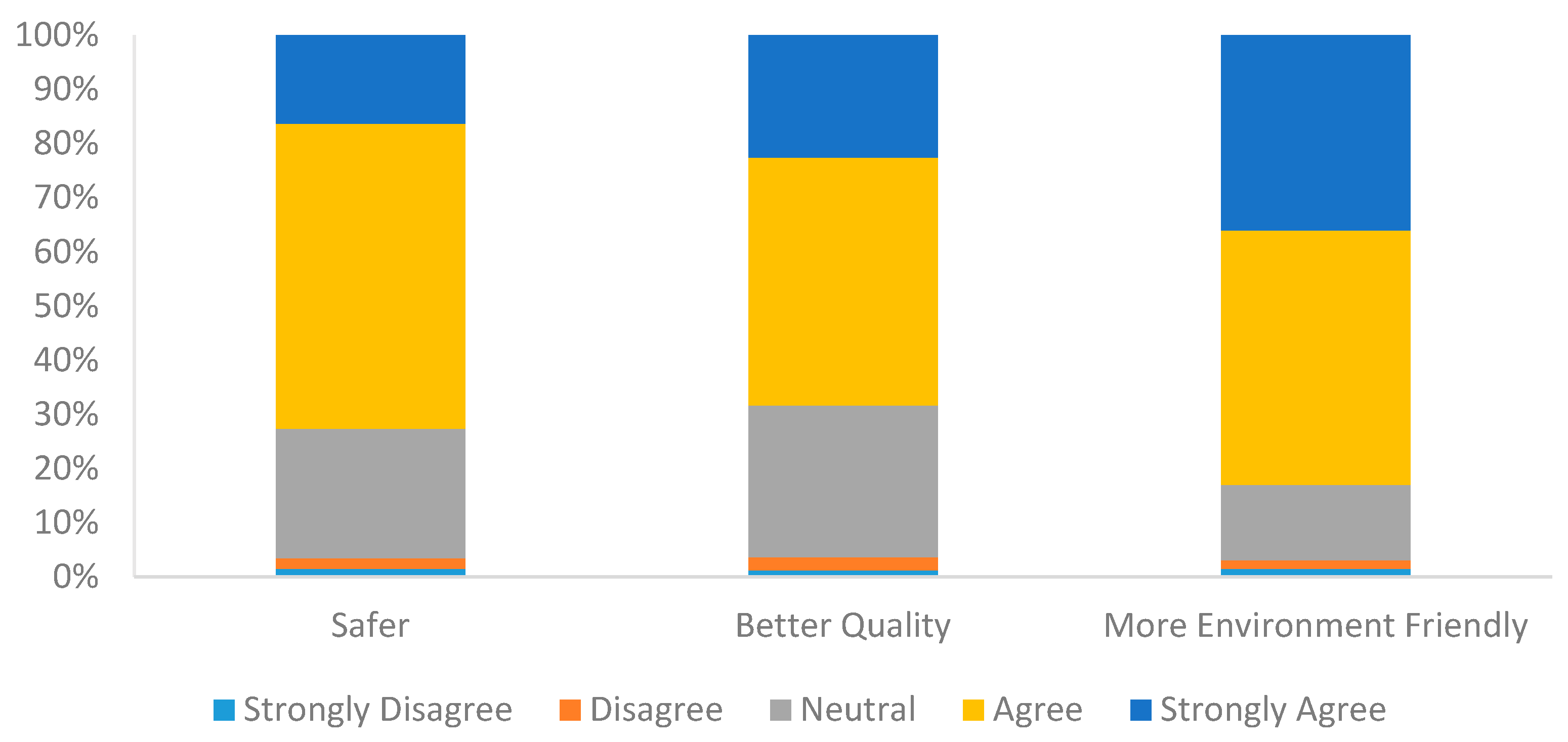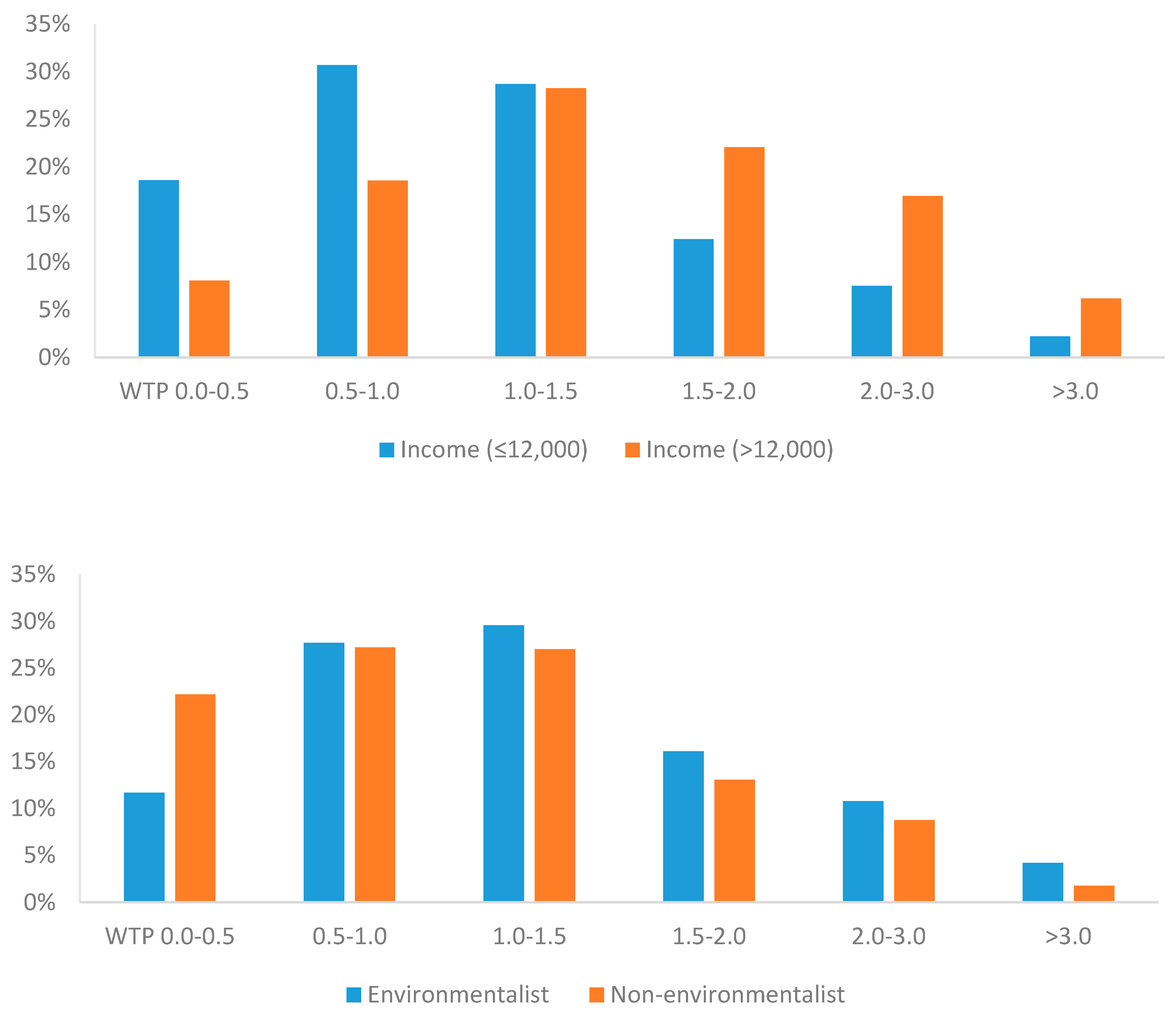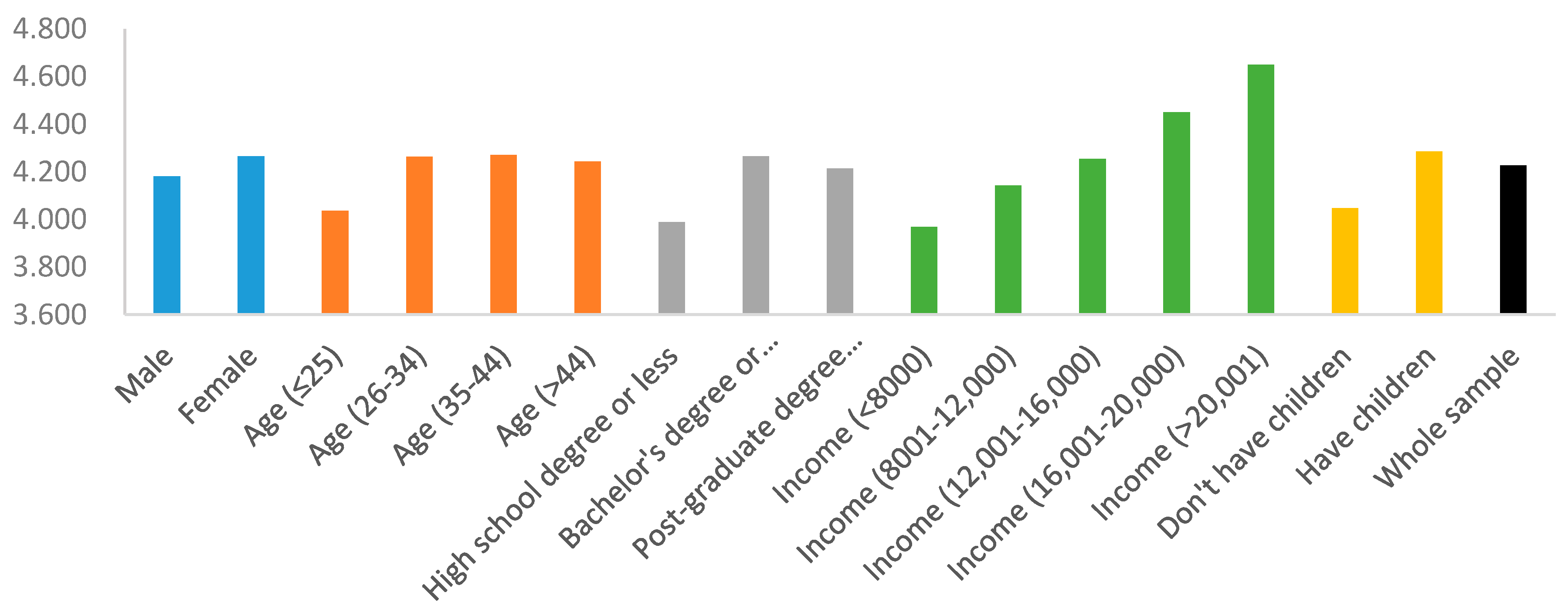Chinese Consumer Quality Perception and Preference of Traditional Sustainable Rice Produced by the Integrated Rice–Fish System
Abstract
:1. Introduction
2. The Integrated Rice–Fish System
3. Literature
4. Methods and Data
4.1. Theoretical Model
4.2. WTP Elicitation Method
4.3. Econometric Model
5. Results
5.1. Perception of Rice–Fish System Rice
5.2. Answers to CV Questions and WTP for Rice from the Rice–Fish System
5.3. Factors Affecting Consumer WTP
6. Conclusions and Discussion
Acknowledgments
Author Contributions
Conflicts of Interest
References
- Hanss, D.; Böhm, G. Sustainability seen from the perspective of consumers. Int. J. Consum. Stud. 2012, 36, 678–687. [Google Scholar] [CrossRef]
- Yanarella, E.J.; Levine, R.S.; Lancaster, R.W. Research and Solutions: “Green” vs. Sustainability: From Semantics to Enlightenment. Sustain. J. Rec. 2009, 2, 296–302. [Google Scholar] [CrossRef]
- United Nations Conference on Trade and Development (UNCTAD). Sustainability Claims Portal. Available online: http://www.unctad.info/en/SustainabilityClaims-Portal/ (accessed on 12 October 2017).
- Gao, Z.; Li, C.; Bai, J.; Fu, J. Chinese consumer quality perception and preference of sustainable milk. China Econ. Rev. 2016. [Google Scholar] [CrossRef]
- Food and Agriculture Organization (FAO). Sustainable Food Consumption and Production; Food and Agriculture Organization of the United Nations: Rome, Italy, 2015. [Google Scholar]
- Briggeman, B.C.; Lusk, J.L. Preferences for fairness and equity in the food system. Eur. Rev. Agric. Econ. 2011, 38, 1–29. [Google Scholar] [CrossRef]
- Vermeir, I.; Verbeke, W. Sustainable food consumption: Exploring the consumer “attitude—Behavioral intention” gap. J. Agric. Environ. Ethic 2006, 19, 169–194. [Google Scholar] [CrossRef]
- Davies, W.P. An Historical Perspective from the Green Revolution to the Gene Revolution. Nutr. Rev. 2003, 61, 124–134. [Google Scholar] [CrossRef]
- Byerlee, D.; Siddiq, A. Has the green revolution been sustained? The quantitative impact of the seed-fertilizer revolution in Pakistan revisited. World Dev. 1994, 22, 1345–1361. [Google Scholar] [CrossRef]
- Loureiro, M.L.; Mccluskey, J.J.; Mittelhammer, R.C. Will Consumers Pay a Premium for Eco-labeled Apples? J. Consum. Aff. 2002, 36, 203–219. [Google Scholar] [CrossRef]
- Sirieix, L.; Delanchy, M.; Remaud, H.; Zepeda, L.; Gurviez, P. Consumers’ perceptions of individual and combined sustainable food labels: A UK pilot investigation. Int. J. Consum. Stud. 2013, 37, 143–151. [Google Scholar] [CrossRef]
- Xie, J.; Gao, Z.; Swisher, M.; Zhao, X. Consumers’ Preferences for Fresh Broccolis: Interactive Effects between Country of Origin and Organic Labels. Agric. Econ. 2015, 47, 181–191. [Google Scholar] [CrossRef]
- Grunert, K.G.; Hieke, S.; Wills, J. Sustainability labels on food products: Consumer motivation, understanding and use. Food Policy 2014, 44, 177–189. [Google Scholar] [CrossRef]
- Vlaeminck, P.; Jiang, T.; Vranken, L. Food labeling and eco-friendly consumption: Experimental evidence from a Belgian supermarket. Ecol. Econ. 2014, 108, 180–190. [Google Scholar] [CrossRef]
- Lagerkvist, C.J.; Hess, S. A meta-analysis of consumer willingness to pay for farm animal welfare. Eur. Rev. Agric. Econ. 2011, 38, 55–78. [Google Scholar] [CrossRef]
- Darby, K.; Batte, M.T.; Ernst, S.; Roe, B. Decomposing local: A conjoint analysis of locally produced foods. Am. J. Agric. Econ. 2008, 90, 476–486. [Google Scholar] [CrossRef]
- Yin, S.; Wu, L.; Du, L.; Chen, M. Consumers’ purchase intention of organic food in China. J. Sci. Food Agric. 2010, 90, 1361–1367. [Google Scholar] [CrossRef] [PubMed]
- Jia, C.; Jukes, D. The national food safety control system of China—A systematic review. Food Control 2013, 32, 236–245. [Google Scholar] [CrossRef]
- Sirieix, L.; Kledal, P.R.; Sulitang, T. Organic food consumers’ trade-offs between local or imported, conventional or organic products: A qualitative study in Shanghai. Int. J. Consum. Stud. 2011, 35, 670–678. [Google Scholar] [CrossRef]
- Li, K. Rice-fish culture in China: A review. Aquaculture 1988, 71, 173–186. [Google Scholar]
- Xia, R.; Wang, S. Historical analysis of Chinese traditional rice fish symbiosis system. Chin. Agric. Sci. Bull. 2009, 25, 245–249. [Google Scholar]
- Huy Giap, D.; Yi, Y.; Kwei Lin, C. Effects of different fertilization and feeding regimes on the production of integrated farming of rice and prawn Macrobrachium rosenbergii (De Man). Aquac. Res. 2015, 36, 292–299. [Google Scholar] [CrossRef]
- Dugan, P.; Dey, M.M.; Sugunan, V.V. Fisheries and water productivity in tropical river basins: Enhancing food security and livelihoods by managing water for fish. Agric. Water Manag. 2006, 80, 262–275. [Google Scholar] [CrossRef]
- Food and Agriculture Organization (FAO). Scaling-Up Integrated Rice-Fish Systems. Available online: www.fao.org/3/a-i4289e.pdf (accessed on 1 September 2017).
- Berg, H. Pesticide use in rice and rice—Fish farms in the Mekong Delta, Vietnam. Crop Prot. 2001, 20, 897–905. [Google Scholar] [CrossRef]
- Halwart, M.; Gupta, M.V. Culture of Fish in Rice Fields. Available online: www.fao.org/3/a-a0823e.pdf (accessed on 12 October 2017).
- Matteson, P.C. Insect Pest Management in Tropical Asian Irrigated Rice. Annu. Rev. Entomol. 2000, 45, 549–574. [Google Scholar] [CrossRef] [PubMed]
- Bleda, M.; Valente, M. Graded eco-labels: A demand-oriented approach to reduce pollution. Technol. Forecast. Soc. Chang. 2009, 76, 512–524. [Google Scholar] [CrossRef]
- Gutierrez, A.; Thornton, T.F. Can consumers understand sustainability through seafood eco-labels? A U.S. and UK case study. Sustainability 2014, 6, 8195–8217. [Google Scholar] [CrossRef]
- Janssen, M.; Hamm, U. Product labelling in the market for organic food: Consumer preferences and willingness-to-pay for different organic certification logos. Food Qual. Preference 2012, 25, 9–22. [Google Scholar] [CrossRef]
- Gifford, K.; Bernard, J.C. The effect of information on consumers’ willingness to pay for natural and organic chicken. Int. J. Consum. Stud. 2011, 35, 282–289. [Google Scholar] [CrossRef]
- Zanoli, R.; Scarpa, R.; Napolitano, F.; Piasentier, E.; Bruschi, S.N.V. Organic label as an identifier of environmentally related quality: A consumer choice experiment on beef in Italy. Renew. Agric. Food Syst. 2013, 28, 70–79. [Google Scholar] [CrossRef]
- Joris, A.; Wim, V.; Koen, M.; Guidovan, H. Personal determinants of organic food consumption: A review. Br. Food J. 2009, 111, 1140–1167. [Google Scholar]
- Van, L.E.; Caputo, V.; Nayga, R.M., Jr.; Meullenet, J.F.; Crandall, P.G.; Ricke, S.C. Effect of organic poultry purchase frequency on consumer attitudes toward organic poultry meat. J. Food Sci. 2010, 75, 384–397. [Google Scholar] [CrossRef] [PubMed]
- Johnston, R.J.; Wessells, C.R.; Donath, H.; Asche, F. Measuring Consumer Preferences for Ecolabeled Seafood: An International Comparison. J. Agric. Resour. Econ. 2001, 26, 20–39. [Google Scholar]
- Nimon, W.; Beghin, J. Are Eco-Labels Valuable? Evidence from the Apparel Industry. Am. J. Agric. Econ. 1999, 81, 801–811. [Google Scholar] [CrossRef]
- Scarpa, R.; Zanoli, R.; Bruschi, V.; Naspetti, S. Inferred and Stated Attribute Non-attendance in Food Choice Experiments. Am. J. Agric. Econ. 2013, 95, 165–180. [Google Scholar] [CrossRef]
- Dransfield, E.; Ngapo, T.M.; Nielsen, N.A.; Bredahl, L.; Sjoden, P.O.; Magnusson, M.; Campo, M.M.; Nute, G.R. Consumer choice and suggested price for pork as influenced by its appearance, taste and information concerning country of origin and organic pig production. Meat Sci. 2005, 69, 61–70. [Google Scholar] [CrossRef] [PubMed]
- Godfray, H.C.J.; Toulmin, C. Food security: The challenge of feeding 9 billion people. Science 2010, 327, 812–818. [Google Scholar] [CrossRef] [PubMed]
- Scarpa, R.; Giudice, R.D. Market Segmentation via Mixed Logit: Extra-Virgin Olive Oil in Urban Italy. J. Agric. Food Ind. Organ. 2004, 2, 1080. [Google Scholar] [CrossRef]
- Liu, Q.; Yan, Z.; Zhou, J. Consumer Choices and Motives for Eco-Labeled Products in China: An Empirical Analysis Based on the Choice Experiment. Sustainability 2017, 9, 331. [Google Scholar] [CrossRef]
- Lancaster, K.J. A New Approach to Consumer Theory. J. Political Econ. 1966, 74, 132–157. [Google Scholar] [CrossRef]
- Hu, W.; Timothy, W.; Sandra, B.; Linda, C.; Wen, Y. Assessing Consumer Willingness to Pay for Value-Added Blueberry Products Using a Payment Card Survey. J. Agric. Appl. Econ. 2011, 43, 243–258. [Google Scholar] [CrossRef]
- Hanemann, W.M. Welfare Evaluations in Contingent Valuation Experiments with Discrete Responses. Am. J. Agric. Econ. 1987, 69, 182–184. [Google Scholar] [CrossRef]
- Grunert, K.G. Food quality and safety: Consumer perception and demand. Eur. Rev. Agric. Econ. 2008, 32, 369–391. [Google Scholar] [CrossRef]
- Muller, L.; Ruffieux, B. Do price-tags influence consumers’ willingness to pay? On the external validity of using auctions for measuring value. Exp. Econ. 2010, 14, 181–202. [Google Scholar] [CrossRef]
- Loomis, J.B. Comparative reliability of the dichotomous choice and open-ended contingent valuation techniques. J. Environ. Econ. Manag. 1990, 18, 78–85. [Google Scholar] [CrossRef]
- Shi, L.; Gao, Z.; Chen, X. The Cross-price Effect on Willingness-to-Pay Estimates in Open-ended Contingent Valuation. Food Policy 2014, 46, 13–21. [Google Scholar] [CrossRef]
- AlvarezFarizo, B. Estimating the Benefits of Agri-environmental Policy: Econometric Issues in Open-ended Contingent Valuation Studies. J. Environ. Plan. Manag. 1999, 42, 23–43. [Google Scholar] [CrossRef]
- Bateman, I.J.; Langford, I.H.; Turner, R.K.; Willis, K.G.; Garrod, G.D. Elicitation and truncation effects in contingent valuation studies. Ecol. Econ. 1995, 12, 161–179. [Google Scholar] [CrossRef]
- Ready, R.C.; Buzby, J.C.; Hu, D. Differences between Continuous and Discrete Contingent Value Estimates. Land Econ. 1996, 72, 397–411. [Google Scholar] [CrossRef]
- Xia, W.; Zeng, Y. Consumer’s Willingness to Pay for Organic Food in the Perspective of Meta-analysis. In Proceedings of the International Conference on Applied Economics (ICOAE), Kastoria, Greece, 15–17 May 2008; pp. 933–943. [Google Scholar]
- Gao, Z.; House, L.A.; Xie, J. Online Survey Data Quality and Its Implication for Willingness-to-Pay: A Cross-Country Comparison. Can. J. Agric. Econ./Revue Canadienne D’agroeconomie 2016, 64, 199–221. [Google Scholar] [CrossRef]
- Gao, Z.; House, L.A.; Bi, X. Impact of Satisficing Behavior in Online Surveys on Consumer Preference And Welfare Estimates. Food Policy 2016, 64, 26–36. [Google Scholar] [CrossRef]
- Amemiya, T. Regression Analysis when the Dependent Variable Is Truncated Normal. Econometrica 1973, 41, 997–1016. [Google Scholar] [CrossRef]
- Yang, S.H.; Ping, Q.; Hu, W.; Liu, Y. Product information and Chinese consumers’ willingness-to-pay for fair trade coffee. China Agric. Econ. Rev. 2014, 6, 278–294. [Google Scholar] [CrossRef]
- Yu, X.; Gao, Z.; Zeng, Y. Willingness to pay for the “Green Food” in China. Food Policy 2014, 45, 80–87. [Google Scholar] [CrossRef]
- Wu, L.; Yin, S.; Xu, Y.; Zhu, D. Effectiveness of China’s Organic Food Certification Policy: Consumer Preferences for Infant Milk Formula with Different Organic Certification Labels. Can. J. Agric. Econ./Revue Canadienne D’agroeconomie 2014, 62, 545–568. [Google Scholar] [CrossRef]
- Van Loo, E.J.; Caputo, V.; Nayga, R.M., Jr.; Verbeke, W. Consumers’ valuation of sustainability labels on meat. Food Policy 2014, 49, 137–150. [Google Scholar] [CrossRef]



| Variables | Definitions |
|---|---|
| WTP | Suppose that the price for conventional rice is 3 yuan/500 g. How much are you willing to pay for rice from the rice-fish system? |
| Environmental Risk Perception | I think the environmental problems is (1 = Very minor, 5 = Very serious). |
| Environmentalist | I am an environmentalist (1 = Strongly disagree, 5 = Strongly agree). |
| Safer | I believe that rice from the rice-fish system is safer environmental friendly (1 = Strongly disagree, 5 = Strongly agree). |
| Better Quality | I believe that rice from the rice-fish system is better quality (1 = Strongly disagree, 5 = Strongly agree). |
| More Environmental Friendly | I believe that rice from the rice-fish system is more environmental friendly (1 = Strongly disagree, 5 = Strongly agree). |
| Variables | Categories | Sample Size | Percent Sample (%) |
|---|---|---|---|
| Gender | Male | 667 | 46.91 |
| Female | 755 | 53.09 | |
| Age | Age (≤25) | 230 | 16.17 |
| Age (26–34) | 642 | 45.15 | |
| Age (35–44) | 387 | 27.22 | |
| Age (>44) | 163 | 11.46 | |
| Education | High school degree or less | 183 | 12.87 |
| Bachelor’s degree or Associate degree | 1135 | 79.82 | |
| Post-graduate degree (MS or doctoral) | 104 | 7.31 | |
| Family Income(RMB/month) | Income (<8000) | 345 | 24.26 |
| Income (8001–12,000) | 408 | 28.69 | |
| Income (12,001–16,000) | 297 | 20.89 | |
| Income (16,001–20,000) | 210 | 14.77 | |
| Income (>20,001) | 162 | 11.39 | |
| Has children | No | 349 | 24.54 |
| Yes | 1073 | 75.46 | |
| Sample Size | 1422 | 100% |
| Parameter | Interval Regression | OLS Regression | ||||
|---|---|---|---|---|---|---|
| Estimate | 95% Confidence Limits | Estimate | 95% Confidence Limits | |||
| Safer | 0.089 * | −0.014 | 0.192 | 0.090 | −0.019 | 0.199 |
| (0.053) | (0.055) | |||||
| Better Quality | 0.109 ** | 0.013 | 0.205 | 0.110 ** | 0.008 | 0.211 |
| (0.049) | (0.052) | |||||
| More Environment Friendly | 0.007 | −0.107 | 0.121 | 0.009 | −0.111 | 0.130 |
| (0.058) | (0.061) | |||||
| Knowledge | 0.050 ** | 0.007 | 0.094 | 0.052 ** | 0.006 | 0.098 |
| (0.022) | (0.023) | |||||
| Environmentalist | 0.064 ** | 0.015 | 0.113 | 0.067 ** | 0.015 | 0.118 |
| (0.025) | (0.026) | |||||
| Environmental risk perception | −0.023 | −0.075 | 0.029 | −0.023 | −0.078 | 0.032 |
| (0.027) | (0.028) | |||||
| Female | 0.071 * | −0.001 | 0.143 | 0.077 ** | 0.001 | 0.152 |
| (0.037) | (0.039) | |||||
| Age | 0.003 | −0.001 | 0.007 | 0.003 | −0.001 | 0.007 |
| (0.002) | (0.002) | |||||
| Income | 0.135 *** | 0.106 | 0.164 | 0.141 *** | 0.110 | 0.171 |
| (0.015) | (0.016) | |||||
| Bachelor’s degree or Associate degree | 0.096 * | −0.017 | 0.209 | 0.094 | −0.025 | 0.213 |
| (0.058) | (0.061) | |||||
| Post-graduate degree (MS or doctoral) | 0.005 | −0.168 | 0.178 | 0.001 | −0.181 | 0.183 |
| (0.088) | (0.093) | |||||
| Has children | 0.115 *** | 0.030 | 0.200 | 0.118 *** | 0.029 | 0.208 |
| (0.043) | (0.046) | |||||
| Intercept | 3.024 *** | 2.697 | 3.350 | 2.993 *** | 2.649 | 3.337 |
| (0.167) | (0.176) | |||||
© 2017 by the authors. Licensee MDPI, Basel, Switzerland. This article is an open access article distributed under the terms and conditions of the Creative Commons Attribution (CC BY) license (http://creativecommons.org/licenses/by/4.0/).
Share and Cite
Wang, E.; Gao, Z. Chinese Consumer Quality Perception and Preference of Traditional Sustainable Rice Produced by the Integrated Rice–Fish System. Sustainability 2017, 9, 2282. https://doi.org/10.3390/su9122282
Wang E, Gao Z. Chinese Consumer Quality Perception and Preference of Traditional Sustainable Rice Produced by the Integrated Rice–Fish System. Sustainability. 2017; 9(12):2282. https://doi.org/10.3390/su9122282
Chicago/Turabian StyleWang, Erpeng, and Zhifeng Gao. 2017. "Chinese Consumer Quality Perception and Preference of Traditional Sustainable Rice Produced by the Integrated Rice–Fish System" Sustainability 9, no. 12: 2282. https://doi.org/10.3390/su9122282




